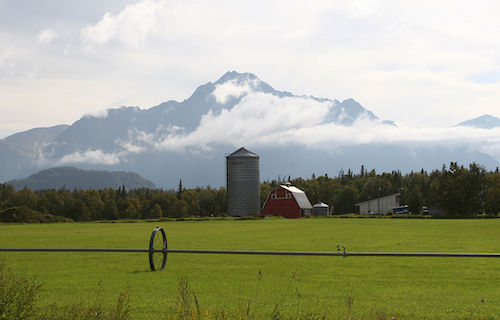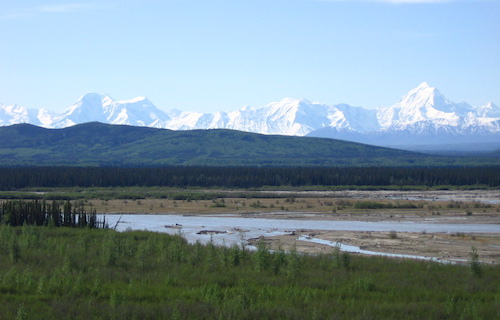Murkowski Directs Significant Funding for Alaska
Senate Committee Advances MilCon-VA, Energy & Water, Agriculture Funding Bills
The Senate Appropriations Committee recently approved the Fiscal Year (FY) 2022 appropriations bills for Military Construction, Veterans Affairs; Energy and Water Development; and Agriculture, Rural Development, Food and Drug Administration, and Related Agencies. As a senior member on the Appropriations Committee, U.S. Senator Murkowski (R-AK) worked to invest in programs and projects critical to Alaskans, including utilizing the opportunity to fund local projects through Congressionally Directed Spending—made possible through a recent reform of the federal appropriations process.
*Note: Numbers are national funding allocations unless specifically noted.
Military Construction, Veterans Affairs
“As an appropriator, meeting the unique needs of Alaska’s military members and veterans is a top priority. Within the MilCon-VA bill, I secured significant support for Alaska, including funding for infrastructure improvements at the permafrost tunnel in Fairbanks as well as funding to support construction projects at bases most vulnerable to climate change. We prioritize initiatives to address mental health challenges and help curb suicide rates among members of the military and our veterans. And in an effort to improve healthcare for Alaska Native veterans, the bill gives the VA the ability to partner with Federally Qualified Health Centers in the State,” said Senator Murkowski. “This legislation is a bipartisan effort to improve the health and livelihood of current and past generations of servicemembers and address the readiness and sustainability of our military installations.”
Bill Highlights:
Military Construction: $11 billion for military construction projects, funding 176 major construction projects at military bases and installations around the world, including in Alaska, to enhance resiliency and support readiness.
- $5.4 million, at the request of Senator Murkowski, to create the physical infrastructure needed to support research and operations at the U.S. Army Corps of Engineers ERDC-CCREL permafrost tunnel in Fairbanks, Alaska.
- $79 million for the Joint Base Elmendorf-Richardson (JBER) runway extension project.
- $39 million for planning and design of projects in INDOPACOM that support the National Defense Strategy.
- $153 million to support properly sized and configured facilities to support Missile Threat and Intelligence Infrastructure, which will be important to Alaska given the state’s robust missile defense infrastructure.
- Promotes energy security at military installations through support for energy-related projects including renewable energy projects to mitigate risk to mission-critical assets.
- Addresses sustainability and readiness at military installations vulnerable to climate change by supporting design, planning, and minor military construction.
- Requires a report on how to expand microgrid demonstration projects, which work to provide energy stability and reliability compared to traditional sources as well as reduce costs and improve efficiency.
- $1.4 billion to improve and maintain housing for servicemembers and their families.
- $105 million, an increase of $85 million, for Child Development Centers. A new Child Development Center was recently built on Fort Wainwright.
Veterans Affairs (VA): $112.9 billion in discretionary funds for the Department of Veterans Affairs (VA), an increase of $8.5 billion over the FY21 enacted level, to address rapidly increasing costs of healthcare and IT support. These resources will provide the healthcare and benefits earned by U.S. servicemembers and veterans.
- $13.2 billion for mental health services. Within that, $2.3 billion is included for suicide prevention outreach and treatment programs, $225 million is provided for the Veterans Crisis Line, more than double the amount from previous years.
- Supports numerous experimental suicide treatment programs and programs to identify suicidal behavior, this includes new potential drug treatments, machine learning, and outreach programs, including telehealth services.
- Works to improve care for rural veterans by calling on the VA to prioritize hiring providers in rural areas, address ongoing deficiencies in access to telehealth services, and requires the VA to submit a report providing analysis on the most difficult-to-reach rural veterans.
- Gives the VA authority to enter agreements with Federally Qualified Health Centers in the State of Alaska to furnish healthcare to veterans in rural Alaska. This allows Alaskan veterans to use medical facilities of the Indian Health Service or tribal organizations.
- $1.6 billion for major construction projects. The Anchorage Mental Health Residential Rehabilitation Treatment Programs facility (Domiciliary Care for Homeless Veterans) was listed as the second highest priority for major construction over the next five years for the VA.
- $2.5 billion for the electronic health record program, with the requirement of quarterly reports to Congress on the expenditures and progress of the program.
- Directs the VA to continue its work to redesign facilities to provide gender-specific care for women veterans.
- Encourages the establishment and maintenance of a PFAS exposure registry for those that may have been exposed to PFAS in aqueous firefighting foam, and directs the VA to prepare a plan to provide PFAS blood testing for those who have served as military firefighters.
Energy and Water Development
“Alaska is home to some of the highest energy costs in the nation, and this bill provides support to help lower those costs. Within the Energy and Water Appropriations bill, we prioritize improving energy efficiency, lowering the cost of energy, and promoting energy innovation. We provide funding for technologies that will reduce carbon emissions, advance clean and efficient energy technology, and develop microgrids. We invest in solutions to make energy more affordable, reliable, clean, diverse, and secure. I’m also proud that I directed funding for a number of critical projects in Alaska that are practical, reasonable improvements to energy and water systems that will have lasting impacts on entire communities.”
Bill Highlights:
Department of Energy (DOE): $44.9 billion, $3 billion above the FY21 enacted level.
- Includes language requested by Senator Murkowski supporting the Arctic Energy Office’s work to continue to bring together assets from across the Department of Energy to work together in collaborative and innovative ways to meet the energy, science, and national security needs of the United States, and its allies in the Arctic. The Arctic Energy Office is tasked with a mission to tackle the energy, science, and national security challenges of the 21st Century.
- Includes language from Senator Murkowski encouraging the Department of Energy to test the effectiveness of Counter-Unmanned Aircraft Systems technologies to protect critical assets.
- $5 million and language by Senator Murkowski for run-of-river hydrokinetic facilities, including environmental analyses and engineering of potential hydrokinetic facilities at sites with high electricity cost and diesel use.
- $398 million for the Weatherization Assistance Program to improve the energy efficiency of low-income families’ homes.
- $70 million for State Energy Programs to invest in energy efficiency, renewable energy, and emergency preparedness.
- $527.5 million for carbon capture utilization and storage and power systems; including $200 million for carbon capture and report language from Senator Murkowski supporting front-end engineering and design studies.
- $122 million for Office of Indian Energy Policy and Programs, and report language supporting the office utilizing subject matter experts to assist Indian Tribes and Alaska Native Villages.
- $25 million for the Experimental Program to Stimulate Competitive Research (EPSCoR) Program.
- $10 million included for R&D of microgrid-related technologies in Indigenous and Islanded regions in the US.
- $12 million for Combined Heat and Power (CHP) Technical Assistance Partnerships.
- $370 million for an Advanced Reactor Demonstration Program, $120 million above the FY21 enacted level.
- $140 million for small modular nuclear reactors, an increase of $30 million above the FY21 enacted level.
Army Corps of Engineers: $8.7 billion, $904 million above the FY21 enacted level.
- $3 million, at the request of Senator Murkowski, for the Lowell Creek Tunnel to protect Seward, Alaska from damaging floodwaters. The Corps designated the tunnel “conditionally unsafe” in 2011 and major flooding in 2012 caused further deterioration.
- $2.5 million, at the request of Senator Murkowski, for Qawalangin Tribe of Unalaska to build a 30 MW geothermal electrical generation facility in Unalaska, Alaska.
- $420,000, at the request of Senator Murkowski, for Alaska Heat Smart to support the installation of air-source heat pumps in lower-income households in Juneau, Alaska.
- $100,000, at the request of Senator Murkowski, for the City of Kivalina to build a biomass refinery.
- $659,000, at the request of Senator Murkowski, to support the construction of a heat recovery system for Togiak, Alaska.
- $540,000, at the request of Senator Murkowski, to provide the Metlakatla Indian Community with an emergency backup generator.
- $2.9 billion for the Construction account, which includes $5 million for the CAP 107 Navigation Program.
- $4.6 billion for the Operations and Maintenance account.
- $8 million for the Tribal Partnership Program.
- $15 million for the National Coastal Mapping Program, of which $5 million is designated for the Arctic Region, due to a directive included by Senator Murkowski.
Denali Commission: $15.1 million, $100,000 above FY21 enacted level.
- Funds economic development and infrastructure in rural Alaska and serves as the lead agency to assist communities facing flooding, permafrost degradation threats and coastal erosion, such as the village relocation of Newtok to Mertarvik.
Agriculture, Rural Development, Food and Drug Administration
“The Agriculture, Rural Development, FDA and Related Agencies appropriations bill has an outsized impact throughout Alaska, impacting everything from food security, support for farmers and ranchers, agricultural research and cooperative extension, access to the internet, housing, water and wastewater projects and more. I am proud to have secured significant funding for Alaskans’ priorities in all of these areas again this year. ”
Bill Highlights:
Micro-Grants for Food Security: The bill provides $6 million for the Micro-Grants for Food Security program, which was created by Senator Murkowski in the 2018 Farm Bill to help support Alaskans’ ability to grown their own food. This represents a $1 million increase over Fiscal Years 2020 and 2021.
GE Salmon Labeling: Building on Senator Murkowski’s longstanding efforts, this legislation includes her provision requiring genetically engineered salmon to be clearly labeled, ensuring Alaskans know what they’re feeding their families.
Congressionally Directed Spending:
- $1.5 million, at the request of Senator Murkowski, for Mat-Su Food Bank warehouse and equipment.
- $840,000, at the request of Senator Murkowski, for the construction of educational facilities at the Sitka Sound Science Center.
- $100,000, at the request of Senator Murkowski, for statewide invasive pest and disease surveys by the Alaska Division of Agriculture.
Programmatic Funding Wins:
- Nutrition
- $5.188 billion, a $149 million increase, for the School Breakfast Program.
- $14.655 billion, a $1.126 billion increase, for the National School Lunch Program.
- $4.314 billion, a $300 million increase, for the Child and Adult Care Food Program.
- $581 million, a $30 million increase, for the Summer Food Service Program, which supports free healthy meals and snacks to children and teens in low-income areas.
- $35 million, an increase of $5 million, for School Meal Equipment grants to help schools upgrade and modernize their food service.
- $6.278 billion, an increase of $278 million, for Special Supplemental Nutrition Program for Women, Infants, and Children (WIC).
- $105 billion to fully fund the Supplemental Nutrition Assistance Program (SNAP).
- $162 million for the Food Distribution Program on Indian Reservations Commodities (FDPIR).
- $998,000 for FDPIR nutrition education projects.
- $337 million for The Emergency Food Assistance Program (TEFAP) Commodities to help food banks feed the hungry, as well as $90 million, an increase of $10 million, for TEFAP Storage and Distribution.
- $332 million, an increase of $7 million, for the Commodity Supplemental Food program, which provides supplemental food boxes to low-income seniors.
- $24 million, an increase of $3 million, for WIC’s Farmer’s Market Nutrition Program, which provides coupons to be used to buy eligible foods from farmers, farmers' markets or roadside stands.
- Agricultural and Environmental Research
- $1.675 billion, an increase of $183 million, for the Agricultural Research Service.
- $275 million, an increase of $16 million, for the Hatch Act, which funds a wide range of research on issues including soil and water, plants and animals, forestry, aquaculture, nutrition, and rural and community development.
- $445 million, an increase of $10 million, for the Agriculture Food and Research Initiative (AFRI) which provides research, education, and extension grants to improve rural economies, increase food security, increase access to water, invest in the agricultural workforce and more.
- $66.75 million, an increase of $2.9 million, from the 15% set-aside in AFRI funding for the USDA’s Experimental Program for Stimulating Competitive Research (EPSCoR) program to help universities develop competitive research, education and extension/outreach programs in high-priority areas of national need in agriculture, food, and environmental sciences.
- Supports for Farmers
- $3 million, an increase of $1 million, for the Geographically Disadvantaged Farmers and Ranchers Reimbursement Transportation Cost Program which helps offset the high cost of farming in non-contiguous states, such as Alaska.
- $330 million, an increase of $15 million, for Smith-Lever 3(b) and (c), which funds land grant colleges and universities’ cooperative extension activities, including the development and dissemination of practical applications of research knowledge, practices, and technologies in agriculture and related subjects, and to encourage the application of such information.
- $10 million, an increase of $1.5 million, for the Veterinary Medicine Loan Repayment program that helps support recruitment and retention of veterinarians, including those who care for farm animals.
- $84.5 million, an increase of $5 million for the Natural Resources Conservation Service Soil Survey to help land owners make informed land use and management decisions that take into consideration various soil characteristics and capabilities to ensure soil is healthy and productive.
- Rural Development
- $73 million, an increase of $5 million, for Rural Utilities Service Rural Water and Waste Disposal Grants for Colonias, Native Americans, and Alaska 306D Funds.
- $700 million for the ReConnect Loan and Grant Program, which provide funds for the costs of construction, improvement, or acquisition of facilities and equipment needed to provide broadband service in eligible rural areas.
- $48 million for Rural Community Facilities Program which offers direct loans, loan guarantees and grants to develop or improve essential public services and facilities in communities across rural America.
- $10 million for High Energy Cost Grant Program which are used to acquire, construction, extend, upgrade, or otherwise improve energy generation, transmission, or distribution facilities.
- Higher Education
- $5 million, an increase of more than $1 million, for Alaska Native and Native Hawaiian Serving Institutions funds to help several University of Alaska campuses.
- $4.1 million for Renewable Resources Extension Act, which provides funding for extension activities related to forestry and natural resources at land-grant universities.
- $10 million, an increase of $1.5 million, for Extension Services at 1994 Institutions (Tribal Colleges & Universities)
- $6 million, an increase of $1.5 million, for Payments to 1994 Institutions grants to support faculty and classes focused on agriculture, natural resources, and human sciences at Tribal Colleges and Universities.
- Environmental Programs:
- $6.5 million for the Grassroots Source Water Protection Program, which helps prevent pollution of surface and ground water used as the primary source of drinking water by rural residents.
- Housing Programs:
- $32 million, a $1 million increase, for Mutual and Self Help Housing Grants, which support families who cooperatively build each other’s homes.
- $1.45 billion, a $40 million increase, for the Rural Housing Section 521 Rental Assistance Program.
- $45 million for Rural Housing Assistance Grants.
Department Directives: Senator Murkowski was also successful in including language in the Committee Report:
- directing USDA to provide flexibility from inappropriate regulations that will make it more difficult for Alaskans to apply for and use Micro-Grants for Food Security Funding;
- directing USDA to allow Summer Food Service Program providers to use innovative methods to feed hungry children in non-congregate settings and by non-congregate means;
- encouraging USDA to prioritize the health and cultural benefits of fish consumption as they revise the regulations for WIC food packages;
- directing USDA to detail its plans to include a greater variety of traditional foods as regular components of FDPIR food baskets, identify additional Native American and Alaska Native producers of traditional foods, and its plans to purchase additional traditional foods from a greater number of indigenous producers and businesses;
- directing the Agricultural Research Service to provide an additional $2 million to the University of Alaska to help develop soil enhancement technologies and to research cereal grains, cover crops, and invasive weeds as they relate to the northern climates in regions dominated by permafrost.
- directing to maintain funding for the Floriculture Crops Report and directing USDA to include data from Alaska; and
- voicing the Committee’s concern that rural communities not on farms are being disadvantaged, clarifying its intent that ReConnect be technology neutral and encouraging the consideration of grants or loans for satellites, or other technologies, if the middle mile infrastructure predominantly serves rural areas, and that the program doesn’t effectively recognize the challenges that different technologies, including satellite, provide to delivering broadband in noncontiguous states or mountainous terrain.








